Jawbreaker
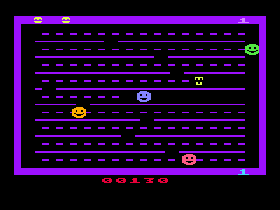 The Game: Ever had a sweet tooth? Now you are the sweet tooth – or teeth, as the case may be. You guide a set of clattering teeth around a mazelike screen of horizontal rows; an opening in each row travels down the wall separating it from the next row. Your job is to eat the tasty treats lining each row until you’ve cleared the screen. Naturally, it’s not just going to be that easy. There are nasty hard candies out to stop you, and they’ll silence those teeth of yours if they catch you – and that just bites. Periodically, a treat appears in the middle of the screen allowing you to turn the tables on them for a brief interval. (Tigervision, 1982)
The Game: Ever had a sweet tooth? Now you are the sweet tooth – or teeth, as the case may be. You guide a set of clattering teeth around a mazelike screen of horizontal rows; an opening in each row travels down the wall separating it from the next row. Your job is to eat the tasty treats lining each row until you’ve cleared the screen. Naturally, it’s not just going to be that easy. There are nasty hard candies out to stop you, and they’ll silence those teeth of yours if they catch you – and that just bites. Periodically, a treat appears in the middle of the screen allowing you to turn the tables on them for a brief interval. (Tigervision, 1982)
Memories: When Atari’s licensed version of Pac-Man hit the store shelves in 1982, it gained an instant notoriety as those looking for the perfect home Pac experience muttered a collective “screw this” and went elsewhere in search of a better game. Tigervision, a subsidiary of Tiger Toys making its first tentative steps into the increasingly-crowded video game arena, gave them that game.
Grand Prix (Atari 2600)
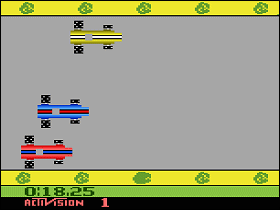
 The Game: Start your digital engines! Grand Prix puts the player behind the wheel of a sleek (and, it has to be said, colorful) race car. With the track scrolling from right to left, the game is simple: get ahead, and don’t crash into the other cars. That may sound easy enough, but hazards such as oil slicks can send a car spinning out of control very easily. (Activision, 1982)
The Game: Start your digital engines! Grand Prix puts the player behind the wheel of a sleek (and, it has to be said, colorful) race car. With the track scrolling from right to left, the game is simple: get ahead, and don’t crash into the other cars. That may sound easy enough, but hazards such as oil slicks can send a car spinning out of control very easily. (Activision, 1982)
Memories: One of David Crane’s earliest games at Activision, Grand Prix is almost as important as a tech demo as it is as a game. Consider the large, blocky pixel-cars Atari‘s first-party racing games; the colorful, finely-detailed cars in Crane’s Grand Prix were a revelation by comparison. Grand Prix brought us cars of many different colors, with animated tires, and none of the sprite flicker that had already come to characterize many a 2600 game by this point. It was yet another case of Activision putting Atari on notice to start bringing its “A” game – literally.
Gorf
 The Game: The Gorfian Empire is attacking Earth, and naturally you’re our only hope. Symmetrical waves of space invaders lead off the invasion, followed by more unpredictable laser attack waves with long-range weapons. Next, you must pick off Gorfian robots as they emerge from a space warp, and finally you take the fight directly to the Gorfian flagship, trying to get one perfect shot in at its most vulnerable point. (CBS Video Games, 1982)
The Game: The Gorfian Empire is attacking Earth, and naturally you’re our only hope. Symmetrical waves of space invaders lead off the invasion, followed by more unpredictable laser attack waves with long-range weapons. Next, you must pick off Gorfian robots as they emerge from a space warp, and finally you take the fight directly to the Gorfian flagship, trying to get one perfect shot in at its most vulnerable point. (CBS Video Games, 1982)
Memories: It’s almost like the original, this home translation from CBS Video Games, though there’s one rather major omission. When Bally/Midway licensed out its popular original coin-op Gorf, it had to make sure that one whole stage of the pioneering multi-level game was left out – the Galaxians screen.
Frogs and Flies
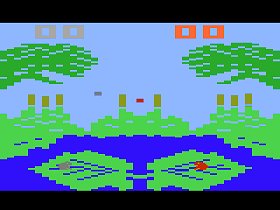 The Game: As one of two lowly bullfrogs, your task is simple: try to nab the greatest number of insect morsels possible on your froggy tongue while hopping around the lily pad. Hey, not every frog can live the wild life of Frogger, can they? (M Network [Mattel], 1982)
The Game: As one of two lowly bullfrogs, your task is simple: try to nab the greatest number of insect morsels possible on your froggy tongue while hopping around the lily pad. Hey, not every frog can live the wild life of Frogger, can they? (M Network [Mattel], 1982)
Memories: An exceedingly simple game, the basic premise of Frogs & Flies was recycled into no fewer than two games for the Atari 2600 (the other exponent of the “frog  eating flies” sub-genre being Atari’s own Frog Pond). Frogs & Flies is basically an Atari 2600 port of Mattel’s Frog Bog cartridge for their own Intellivision platform, a game which in turn “borrowed” its concept from Gremlin’s 1978 Frogs coin-op.
eating flies” sub-genre being Atari’s own Frog Pond). Frogs & Flies is basically an Atari 2600 port of Mattel’s Frog Bog cartridge for their own Intellivision platform, a game which in turn “borrowed” its concept from Gremlin’s 1978 Frogs coin-op.
Frog Bog

 The Game: One or two players control one (or two) hungry frogs, each on its own lily pad. Flies flitter past overhead, and it’s the player’s job to get his frog to jump to just the right altitude, facing just the right direction, and to send his frog’s tongue snapping out to gobble up a fly at just the right time. The diremelyction of each frog can also be controller – frogs can go from pad to pad, but be careful not to land a frog in the drink; he then loses precious time swimming back to his lily pad while the other frog can be gobbling up more tasty flies. The game follows a complete day in the life of the frogs, from morning to night. Whoever snaps up 100 points worth of flies wins the game. (Mattel Electronics, 1982)
The Game: One or two players control one (or two) hungry frogs, each on its own lily pad. Flies flitter past overhead, and it’s the player’s job to get his frog to jump to just the right altitude, facing just the right direction, and to send his frog’s tongue snapping out to gobble up a fly at just the right time. The diremelyction of each frog can also be controller – frogs can go from pad to pad, but be careful not to land a frog in the drink; he then loses precious time swimming back to his lily pad while the other frog can be gobbling up more tasty flies. The game follows a complete day in the life of the frogs, from morning to night. Whoever snaps up 100 points worth of flies wins the game. (Mattel Electronics, 1982)
Memories: As a concept, Frog Bog had been around since the 1970s, with the basic game play of two frogs competing for flies dating back to the B&W days of the arcade. But even if the game itself wasn’t anything new, it never got a better graphical treatment than it did in Frog Bog. This is one of those games that showed up incessantly in early press and advertising material about the Intellivision, and with good reason – it’s a simple, fun game married to just the right graphics and sounds.
Frogger
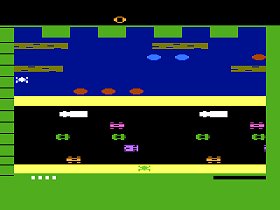 The Game: As in the arcade game of the same name, you try to help an amiable amphibian amble his way through rush hour traffic and a river full of dangers in a quest to get home. (Parker Brothers, 1982)
The Game: As in the arcade game of the same name, you try to help an amiable amphibian amble his way through rush hour traffic and a river full of dangers in a quest to get home. (Parker Brothers, 1982)
Memories: While faithful to its namesake, the Atari 2600 edition of Frogger is hampered not by the 2600’s graphical limitations, but by the flickering caused by the presence of more animated characters on the screen than the machine could keep track of. When you consider that the Atari 2600 encountered this problem if there were ever more than four sprites on the screen at the same time, you begin to see the problem with Frogger and its playing field chock full of traffic, and the river full of turtles and logs.
Freedom Fighters!
 The Game: Using the left joystick, you control the movement of your ship within the confines of a screen filled with mines, alien aggressors, and occasional purple “confinement crystals” which you have to catch, because these contain human prisoners of war. The right joystick engages your hyperdrive, enabling you to go zipping along in true Defender style. (North American Philips, 1982)
The Game: Using the left joystick, you control the movement of your ship within the confines of a screen filled with mines, alien aggressors, and occasional purple “confinement crystals” which you have to catch, because these contain human prisoners of war. The right joystick engages your hyperdrive, enabling you to go zipping along in true Defender style. (North American Philips, 1982)
Memories: Another infamous “not quite a copy of a popular arcade game” from the Odyssey2 gang, Freedom Fighters was supposed to be similar to Defender, but somehow it misses the mark.
Fishing Derby
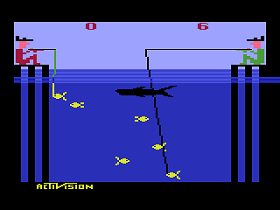 The Game: You (and a friend, in the two-player game) are sitting on the dock of the bay, watching the time float away, and trying to catch some dinner at the same time. There’s only one problem: apparently Roy Scheider led you to this fishin’
The Game: You (and a friend, in the two-player game) are sitting on the dock of the bay, watching the time float away, and trying to catch some dinner at the same time. There’s only one problem: apparently Roy Scheider led you to this fishin’  hole, because there’s a shark roaming the waters near the surface – and he’ll happily eat your fish (the shark, that is, not Roy Scheider) if you happen to reel them in while he’s facing you. Some of the fish will put up a mighty struggle when caught, which can also lead them to a date with the shark. The first to snag a hundred fishies wins. (Activision, 1982)
hole, because there’s a shark roaming the waters near the surface – and he’ll happily eat your fish (the shark, that is, not Roy Scheider) if you happen to reel them in while he’s facing you. Some of the fish will put up a mighty struggle when caught, which can also lead them to a date with the shark. The first to snag a hundred fishies wins. (Activision, 1982)
Memories: Put away the current gen fishing reel controllers, this is where the odd sport of video fishing began. Fishing Derby, one of Activision’s early offerings, is proof that, once upon a time, imagination dominated the game-making scene instead of marketing considerations reigning supreme.
Fire Fighter
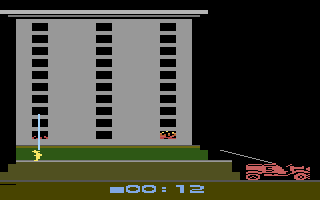 The Game: It’s a three-alarm fire! Or so the packaging would have you believe. It’s actually more of a .5-alarm fire, giving you more than enough time to extinguish the blaze and rescue the poor soul who’s trapped in the building. Higher diffuculty levels actually give the game some challenge. Needless to say, letting the fire consume the building (or the person inside) does not brighten your prospects for a video game fire-fighting career. (Imagic, 1982)
The Game: It’s a three-alarm fire! Or so the packaging would have you believe. It’s actually more of a .5-alarm fire, giving you more than enough time to extinguish the blaze and rescue the poor soul who’s trapped in the building. Higher diffuculty levels actually give the game some challenge. Needless to say, letting the fire consume the building (or the person inside) does not brighten your prospects for a video game fire-fighting career. (Imagic, 1982)
Memories: Fire Fighter has always struck me as an oddity among the legendarily challenging Imagic games that accompanied it to the store shelves. Cosmic Ark, Atlantis and Moonsweeper were nothing to sneeze at. On its default skill level, Fire Fighter is something to snooze at.
Galaxian
 The Game: In one of the most seminal variations on the Space Invaders format, Galaxian was among the first clones to introduce attacking formations that would break off from the usual rows and columns of invaders. Though Galaxian‘s use of this innovation was minimal, it was a drastic change from the usual slowly-advancing target gallery. (Atari, 1982)
The Game: In one of the most seminal variations on the Space Invaders format, Galaxian was among the first clones to introduce attacking formations that would break off from the usual rows and columns of invaders. Though Galaxian‘s use of this innovation was minimal, it was a drastic change from the usual slowly-advancing target gallery. (Atari, 1982)
Memories: Like the 5200 version of Pac-Man, Galaxian is a good demonstration of the next-generation Atari console soundly trouncing its older brother. Galaxian is no slouch on the Atari 2600,  but while the game play is relatively intact, the look and feel of the arcade game didn’t survive that particular translation. Those elements are handled much more faithfully in this version of the game, though.
but while the game play is relatively intact, the look and feel of the arcade game didn’t survive that particular translation. Those elements are handled much more faithfully in this version of the game, though.
Fast Food
 The Game: You’re a disembodied pair of jaws – sort of like that old wind-up clacking teeth toy, minus the wind-up part. And the feet. Food flies at you from the left side of the screen, and your job is to gobble all of it up that you can reach. (Try not to dwell on the digestive process involved with a disembodied pair of jaws – presumably there’s a grateful disembodied stomach somewhere in this food chain.) The more snacks you snag, the faster the food flies. Beware of the purple peppers, though – you can only eat so many of them before your jaws erupt in a cataclysmic, game-ending “BURP!” (Telesys, 1982)
The Game: You’re a disembodied pair of jaws – sort of like that old wind-up clacking teeth toy, minus the wind-up part. And the feet. Food flies at you from the left side of the screen, and your job is to gobble all of it up that you can reach. (Try not to dwell on the digestive process involved with a disembodied pair of jaws – presumably there’s a grateful disembodied stomach somewhere in this food chain.) The more snacks you snag, the faster the food flies. Beware of the purple peppers, though – you can only eat so many of them before your jaws erupt in a cataclysmic, game-ending “BURP!” (Telesys, 1982)
Memories: This is another game to file away under the category of “games that simply would not be made or marketed today.” As the healthy living movement (not a bad thing) collides and coalesces with the zombie-like conformity movement (almost always a bad thing) and some collective decision has been taken somewhere that overweight people are now as offensive to the general public as chain-smokers, a game like Fast Food – which congratulates players between levels with the tongue-in-cheek message “You’re Getting Fatter” – just wouldn’t make it to the store shelves today. (At this rate, I’m waiting for Pac-Man, with its unrestrained eating, to become somehow politically incorrect.)
E.T.
The Game: In something that would best be described as a very vague homage to the Steven Spielberg film of the same name, E.T. allows you to guide the intrepid (and cute) extra-terrestrial on a quest to find Reese’s  Pieces and transmitter pieces (with which one can, presumably, phone home), while avoiding the threatening (but cute) doctors and FBI agents. If you get into a scrape, the helpful (and cute) Elliott may be able to pry you out of a sticky situation. You may then resume your pointless quest until, inevitably, you wind up withering away at the bottom of one of the many pits in the game. (Atari, 1982)
Pieces and transmitter pieces (with which one can, presumably, phone home), while avoiding the threatening (but cute) doctors and FBI agents. If you get into a scrape, the helpful (and cute) Elliott may be able to pry you out of a sticky situation. You may then resume your pointless quest until, inevitably, you wind up withering away at the bottom of one of the many pits in the game. (Atari, 1982)
Memories: A few phrases pop into my head when I think about this game, among them: “waste of time,” “cheap licensing cash-in,” and “was there ever anything nearly this lame for the Odyssey2?” As many have noticed, the vast majority of the effort poured, or dripped as the case may be, into E.T. was spent on the opening title screen. Pretty impressive stuff for the 2600, but the game was much more satisfying if one never got past that title screen.
The Empire Strikes Back
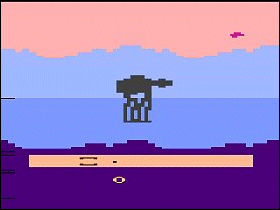 The Game: Derived from an action scene in the second of a trilogy of little-known films about a budding Jedi Knight named Luke Skywalker, The Empire Strikes Back puts you in the cockpit of Luke’s snowspeeder in a desperate bid to beat back huge Imperial Walkers – also known as AT-ATs – from destroying the Rebel back on the ice planet of Hoth. The AT-ATs’ heavy artillery can seriously deplete your snowspeeder’s shielding with a single hit, though you must score numerous direct hits before you can even begin to have the same effect on the onslaught of Imperial Walkers, let alone destroy one. Occasionally, a weakness will be exposed in the “neck” region of the huge mechanical monsters, and you’ll have a few seconds in which you may take advantage of that and blow the machine away. And even less frequently, the triumphant strains of John Williams’ Star Wars theme – as squeaked out by the Atari 2600’s limited sound facility – will signal that the Force is with you, rendering you invincible for a short period of time. You’re going to need it. (Parker Brothers, 1982)
The Game: Derived from an action scene in the second of a trilogy of little-known films about a budding Jedi Knight named Luke Skywalker, The Empire Strikes Back puts you in the cockpit of Luke’s snowspeeder in a desperate bid to beat back huge Imperial Walkers – also known as AT-ATs – from destroying the Rebel back on the ice planet of Hoth. The AT-ATs’ heavy artillery can seriously deplete your snowspeeder’s shielding with a single hit, though you must score numerous direct hits before you can even begin to have the same effect on the onslaught of Imperial Walkers, let alone destroy one. Occasionally, a weakness will be exposed in the “neck” region of the huge mechanical monsters, and you’ll have a few seconds in which you may take advantage of that and blow the machine away. And even less frequently, the triumphant strains of John Williams’ Star Wars theme – as squeaked out by the Atari 2600’s limited sound facility – will signal that the Force is with you, rendering you invincible for a short period of time. You’re going to need it. (Parker Brothers, 1982)
Memories: The Empire Strikes Back is just one in a series of excellent Star Wars-themed game cartridges released around this time by Parker Brothers (other titles included Star Wars: The Arcade Game, an excellent adaptation of the Atari vector arcade game, and the intriguing Return of the Jedi: Death Star Battle).
Eggomania (Atari 2600)
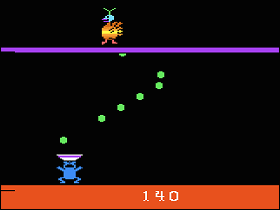 The Game: Which came first: your imminent defeat or the egg? A crazed chicken scoots back and forth across the top of the screen, hurling eggs downward at your suspiciously Cookie Monster-esque protagonist. Once your monster has captured all of the eggs (missing even one egg results in a lost “life”), you can fire the eggs back at the chicken and try to score a direct hit. (U.S. Games, 1982)
The Game: Which came first: your imminent defeat or the egg? A crazed chicken scoots back and forth across the top of the screen, hurling eggs downward at your suspiciously Cookie Monster-esque protagonist. Once your monster has captured all of the eggs (missing even one egg results in a lost “life”), you can fire the eggs back at the chicken and try to score a direct hit. (U.S. Games, 1982)
Memories: U.S. Games, formerly Vidtec, is one company that industry insiders single out as a prime example that speculators and bandwagon-jumpers were beginning to dominate the third-party software industry around 1982. U.S. Games didn’t really have a breakout hit or a killer app; instead, they had the distinction of being an upstart video game company that happened to be a wholly owned subsidiary of Quaker Oats – a company with no previous interest in the video game field.
Dracula
 The Game: Looking for a game where you can spread your wings a little? If bat wings are okay, then Dracula is the game for you. As the impaler himself, you wander the city streets at night, looking for victims to bite. Whether you’re chasing a fleet-footed mortal or avoiding adversaries who also roam the streets, turning into a bat is often the only way to fly. You also have to keep an eye on the clock – if you haven’t returned safely to your crypt by sunrise, Dracula turns to dust. (Imagic, 1982)
The Game: Looking for a game where you can spread your wings a little? If bat wings are okay, then Dracula is the game for you. As the impaler himself, you wander the city streets at night, looking for victims to bite. Whether you’re chasing a fleet-footed mortal or avoiding adversaries who also roam the streets, turning into a bat is often the only way to fly. You also have to keep an eye on the clock – if you haven’t returned safely to your crypt by sunrise, Dracula turns to dust. (Imagic, 1982)
Memories: Yet another Intellivision-only gem from the gang at Imagic, Dracula would seem, on the surface, to do some of the same things that Texas Chainsaw Massacre does on the Atari VCS: it puts the player in the role of the villain of the piece, going through the game and searching for victims. But where Texas Chainsaw Massacre tries (rather unsuccessfully, it must be said) to reach for Tobe Hooper-worthy shock value, Dracula keeps things simple – and it makes sure the player is vulnerable too.
Dragonfire
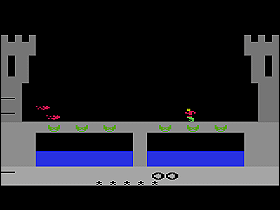 The Game: Introducing the ultimate in home security systems: a huge fire-breathing dragon. No keypads or extra power sources necessary! The amazing new dragon will repel any looters from the castle he’s guarding by belching unpredictable barrages of fire across the castle drawbridge. And even if an intrepid looter does gain access to the castle, the dragon will fend off the unwelcome visitor’s attempts to grab the castle’s treasure with an endless hail of fireballs, toasting the looter on contact. If the looter should happen to grab all the treasure – which is highly, highly unlikely due to the rugged design of the dragon – an escape hatch will appear and he’s free to try his luck from the drawbridge again. But it’s very unlikely that any looter will survive a second attempt…which is actually rather unfortunate, since you’re the treasure hunter in this game. (Imagic, 1982)
The Game: Introducing the ultimate in home security systems: a huge fire-breathing dragon. No keypads or extra power sources necessary! The amazing new dragon will repel any looters from the castle he’s guarding by belching unpredictable barrages of fire across the castle drawbridge. And even if an intrepid looter does gain access to the castle, the dragon will fend off the unwelcome visitor’s attempts to grab the castle’s treasure with an endless hail of fireballs, toasting the looter on contact. If the looter should happen to grab all the treasure – which is highly, highly unlikely due to the rugged design of the dragon – an escape hatch will appear and he’s free to try his luck from the drawbridge again. But it’s very unlikely that any looter will survive a second attempt…which is actually rather unfortunate, since you’re the treasure hunter in this game. (Imagic, 1982)
Memories: An addictive little number, this Dragonfire. Granted, the Intellivision version of this game looks fancier – well, compared to the 2600 cartridge, almost every other version of Dragonfire has a little more audiovisual flair.
Dragonfire
 The Game: You’re another treasure-hunting glory seeker who’s about to meet more than his match. If you can survive crossing the drawbridge into the castle – a task made incredibly difficult by the glowing fireballs of dragon breath being hurled toward you – you’ve got an even more hazardous obstacle ahead: the dragon himself is guarding a huge stash of treasure. Even if he can’t stop you from pocketing every shiny thing in the castle, chances are you won’t make it out alive. (Imagic, 1982)
The Game: You’re another treasure-hunting glory seeker who’s about to meet more than his match. If you can survive crossing the drawbridge into the castle – a task made incredibly difficult by the glowing fireballs of dragon breath being hurled toward you – you’ve got an even more hazardous obstacle ahead: the dragon himself is guarding a huge stash of treasure. Even if he can’t stop you from pocketing every shiny thing in the castle, chances are you won’t make it out alive. (Imagic, 1982)
Memories: This is a game that worked well with the Intellivision’s disc controller. Especially on the second screen. It’s a rare case where I don’t mind that devilishly difficult controller at all. Vastly expanded from the same game as we knew it on the Atari 2600, Dragonfire is yet another example of Imagic concocting pure genius for the Intellivision.
Donkey Kong Jr.
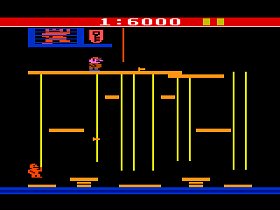 The Game: As little Donkey Kong Jr., you’re trying to reach the top of a treacherous series of vines and platforms to rescue your dad from Mario. (Coleco, 1982)
The Game: As little Donkey Kong Jr., you’re trying to reach the top of a treacherous series of vines and platforms to rescue your dad from Mario. (Coleco, 1982)
Memories: I’m a “junior” myself, so I understand that there are certain challenges involved in living up to the name of one’s forebears. And though the little ape was going to have a big task in living up to his dad’s name – after all, Kong Sr.’s game was the foundation of Nintendo’s empire – the original Donkey Kong Jr. arcade game was a great deal of fun. But Coleco did Donkey Kong Jr. a grave injustice in its translation for the Atari 2600.
Donkey Kong
 The Game: In the rotund plumber Mario’s first adventure, you have to help him reach the top of a perilous scaffolding to rescue a damsel in distress from the dastardly Donkey Kong. (Coleco, 1982)
The Game: In the rotund plumber Mario’s first adventure, you have to help him reach the top of a perilous scaffolding to rescue a damsel in distress from the dastardly Donkey Kong. (Coleco, 1982)
Memories: Remember how much of a train wreck Coleco made of Donkey Kong when they made that dismal version of it for the Atari 2600? Well, if anything, Coleco’s equally mind-numbing translation of Nintendo’s original smash hit for the Intellivision proves that Coleco was definitely trying to make their ColecoVision version of Donkey Kong look better.
Donkey Kong
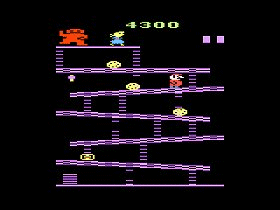 The Game: In the rotund plumber Mario’s first adventure, you have to help him reach the top of a perilous scaffolding to rescue a damsel in distress from the dastardly Donkey Kong. (Coleco, 1982)
The Game: In the rotund plumber Mario’s first adventure, you have to help him reach the top of a perilous scaffolding to rescue a damsel in distress from the dastardly Donkey Kong. (Coleco, 1982)
Memories: Once upon a time, Nintendo didn’t manufacture its own home video game system. Perhaps games like this convinced it to pick up the habit. Coleco did a very good job of translating Nintendo’s first arcade hit into its first game for the higher-priced ColecoVision console, but truthfully, more people had an Atari 2600 at the time, and this is the version of Donkey Kong they got.
Donkey Kong
 The Game: In a very faithful adaptation of Nintendo’s all-time classic arcade game, you’re Mario, a rotund and lovesick fellow who would gladly scale scaffolding, bound over barrels and feint past foxfires, all to save the damsel in distress. (Coleco, 1982)
The Game: In a very faithful adaptation of Nintendo’s all-time classic arcade game, you’re Mario, a rotund and lovesick fellow who would gladly scale scaffolding, bound over barrels and feint past foxfires, all to save the damsel in distress. (Coleco, 1982)
The Game: This was it, friends. This was what sold the ColecoVision. Donkey Kong was one of the hottest games in arcades at that time, and Coleco was smart enough to grab the rights from Nintendo as well as to make it the pack-in cartridge for the ColecoVision (like Combat was the pack-in for the Atari 2600).
Demon Attack
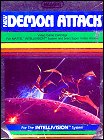 The Game: Demons coalesce into existence in mid-air above your cannon. Send them back where they came from by force – but watch out, as demons in later levels split into two parts upon being hit, which must then be destroyed individually. After fending off several waves of attackers, you blast off to deep space to confront their mothership. (Imagic, 1982)
The Game: Demons coalesce into existence in mid-air above your cannon. Send them back where they came from by force – but watch out, as demons in later levels split into two parts upon being hit, which must then be destroyed individually. After fending off several waves of attackers, you blast off to deep space to confront their mothership. (Imagic, 1982)
Memories: No bones about it, the Intellivision version of Demon Attack is the definitive version of this game. It also drew a lawsuit from Atari, who had just licensed the arcade game Phoenix from Centuri (an American operation which had, in turn, licensed it from Taito in Japan). In a lot of ways, Phoenix and the Intellivision version of Demon Attack were very much alike – swooping alien attackers who split into two equally lethal halves when hit, and a Comet Empire-like alien mothership with only a single vulnerability (and an endless stream of defensive fighters to cover that weakness).
Demon Attack
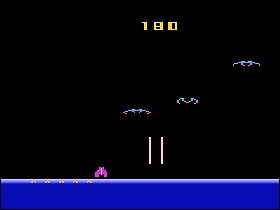
 The Game: Demons coalesce into existence in mid-air above your cannon. Send them back where they came from by force – but watch out, as demons in later levels split into two parts upon being hit, which must then be destroyed individually… (Imagic, 1982)
The Game: Demons coalesce into existence in mid-air above your cannon. Send them back where they came from by force – but watch out, as demons in later levels split into two parts upon being hit, which must then be destroyed individually… (Imagic, 1982)
Memories: Ah, the storied history of Demon Attack. Back in the day when the legal game was almost as new the video game, Atari was jealously guarding its territory. Now, never mind that Bushnell-era Atari had clearly based some of its cartridge games on arcade sleeper hits – Circus Atari borrowed heavily from Exidy’s coin-op Circus, to name just one – the company was now out for blood under the management of Warner Bros. and Ray Kassar.
Dark Caverns
 The Game: Robots, spiders and critters, oh my! You’re a lone human in a maze teeming with deadly robots, spiders and other nasties, and your trusty gun – which can dispatch any or all of the above – has only a limited amount of ammunition. You can obtain more ammo by walking over a briefly-occurring flashing gun symbol – but until then, if you’re out of ammo, you’re no longer the hunter, but the hunted. (M Network [Mattel], 1982)
The Game: Robots, spiders and critters, oh my! You’re a lone human in a maze teeming with deadly robots, spiders and other nasties, and your trusty gun – which can dispatch any or all of the above – has only a limited amount of ammunition. You can obtain more ammo by walking over a briefly-occurring flashing gun symbol – but until then, if you’re out of ammo, you’re no longer the hunter, but the hunted. (M Network [Mattel], 1982)
Memories: This was the 2600 version of a similar game that Mattel had released for its own Intellivision console (Night Stalker), and it’s fair to say that this edition was just a wee bit simplified.
Cosmic Ark
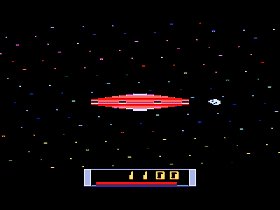 The Game: As the commander of a spacefaring Ark, your mission is to retrieve two members of every species on every planet you visit, in case the constant ruch of asteroids and meteors renders life on those planets extinct. In the initial screen, the large Ark spacecraft is besieged by meteors appearing from every direction, and your job is to use the ship’s weapons the destroy the space rock before they destroy your Ark. After surviving this screen, the Ark descends into low orbit of a planet, and you pilot the scout ship, avoiding planetary defenses to grab two specimens of that planet’s dominant life form with your tractor beam. (Sorry, you don’t get to make crop circles while you’re doing your alien abductions.) If the planetary defenses hit your scout ship, you launch another one, but time is running out – eventually another meteor will plummet from the sky right into the Ark, and you can only defend the Ark if the scout ship has re-docked. When the final destruction of the Cosmic Ark comes at last, the tiny scout ship escapes into deep space… (Imagic, 1982)
The Game: As the commander of a spacefaring Ark, your mission is to retrieve two members of every species on every planet you visit, in case the constant ruch of asteroids and meteors renders life on those planets extinct. In the initial screen, the large Ark spacecraft is besieged by meteors appearing from every direction, and your job is to use the ship’s weapons the destroy the space rock before they destroy your Ark. After surviving this screen, the Ark descends into low orbit of a planet, and you pilot the scout ship, avoiding planetary defenses to grab two specimens of that planet’s dominant life form with your tractor beam. (Sorry, you don’t get to make crop circles while you’re doing your alien abductions.) If the planetary defenses hit your scout ship, you launch another one, but time is running out – eventually another meteor will plummet from the sky right into the Ark, and you can only defend the Ark if the scout ship has re-docked. When the final destruction of the Cosmic Ark comes at last, the tiny scout ship escapes into deep space… (Imagic, 1982)
Memories: Another addictive entry, though a bit simpler than Atlantis, this game was way ahead of its time – an alien abduction game, even one which gives the player control of the aliens, would go over phenomenally with modern-day UFO enthusiasts.
Commando Raid
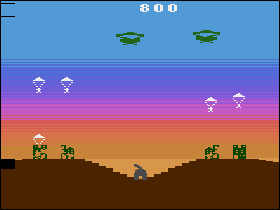 The Game: Helicopters and planes are dumping paratroopers directly over your land-locked cannon. Your job is to take out both aircraft and paratroopers before the enemy can land on and slowly destroy the rows of buildings on either side of the cannon. Once enemy paratroopers raze a building to the ground, they begin doing something even deadlier: digging tunnels toward your cannon so they can destroy it from below with a giant bomb, at which time your point defense career is over. (U.S. Games, 1982)
The Game: Helicopters and planes are dumping paratroopers directly over your land-locked cannon. Your job is to take out both aircraft and paratroopers before the enemy can land on and slowly destroy the rows of buildings on either side of the cannon. Once enemy paratroopers raze a building to the ground, they begin doing something even deadlier: digging tunnels toward your cannon so they can destroy it from below with a giant bomb, at which time your point defense career is over. (U.S. Games, 1982)
Memories: A clever riff on a well-known game, Commando Raid avoids being just another Missile Command clone. At first glance, the element of defending six cities/buildings by covering the entire sky from a fixed position seems familiar, but the gradual enemy occupation of territory beneath the player’s cannon adds an original twist and requires some new strategy.
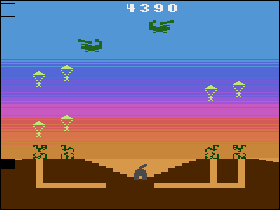 U.S. Games didn’t exactly make stuff that looked like Activision‘s games, but the audiovisual element of Commando Raid is more than adequate to convey all the information players need. The buildings have several stages of disrepair, from undamaged down to rubble. The sheer twitch factor as multiple incoming targets have to be dealt with is impressive for a VCS cartridge, as is the fact that the barrage of approaching enemies is accomplished with virtually none of the dreaded “flicker” that has plagued countless other games on this platform.
U.S. Games didn’t exactly make stuff that looked like Activision‘s games, but the audiovisual element of Commando Raid is more than adequate to convey all the information players need. The buildings have several stages of disrepair, from undamaged down to rubble. The sheer twitch factor as multiple incoming targets have to be dealt with is impressive for a VCS cartridge, as is the fact that the barrage of approaching enemies is accomplished with virtually none of the dreaded “flicker” that has plagued countless other games on this platform.
 Seasoned Missile Commanders looking for a new posting can do a lot worse than signing up to go Commando.
Seasoned Missile Commanders looking for a new posting can do a lot worse than signing up to go Commando.
Cosmic Creeps
 The Game: Aliens are after your kids! Fortunately, you’re armed with a resource that not everyone has: your own flying saucer. In the opening screen, you have to return to the saucer to resume command, and then you signal your kids to come up, one by one, as you try to pick off alien pursuers who are hot on their trail. If you’re not careful, you can actually zap the kids instead. If an alien manages to reach your saucer, someone else will have to give your kids a ride home from the star academy… (Telesys, 1982)
The Game: Aliens are after your kids! Fortunately, you’re armed with a resource that not everyone has: your own flying saucer. In the opening screen, you have to return to the saucer to resume command, and then you signal your kids to come up, one by one, as you try to pick off alien pursuers who are hot on their trail. If you’re not careful, you can actually zap the kids instead. If an alien manages to reach your saucer, someone else will have to give your kids a ride home from the star academy… (Telesys, 1982)
Memories: It may not have been the biggest, most obvious name in software for the 2600, but I have to give Telesys top marks for coming up with cool ideas for their games. Cosmic Creeps is a great example of what Telesys was best at, and it’s a lot of fun too.
Clean Sweep
 The Game: Years before Robovac and Roomba, there was Clean Sweep, a vacuum cleaner patrolling the vaults of a bank and picking up stray bits of money. (Makes you wonder who programmed it, and who’s emptying the bag!) As you grab more wayward currency, your bag fills up; when you hear an alarm sound, you have to go to the center of the maze to empty your bag and start anew; until you do that, you can’t pick up any more dead presidents. But those aren’t the only alarm bells going off here: things that look alarmingly like huge forceps are chasing you around. If they grab you, it’s your money and your life. There are four corners in the vault that will power up your vacuum cleaner temporarily, enabling you to suck up those forceps and (for a brief while) grab all the cash in your path without filling your bag. Clearing the maze advances you to the next level; losing all your lives leaves the bank wide open. (GCE, 1982)
The Game: Years before Robovac and Roomba, there was Clean Sweep, a vacuum cleaner patrolling the vaults of a bank and picking up stray bits of money. (Makes you wonder who programmed it, and who’s emptying the bag!) As you grab more wayward currency, your bag fills up; when you hear an alarm sound, you have to go to the center of the maze to empty your bag and start anew; until you do that, you can’t pick up any more dead presidents. But those aren’t the only alarm bells going off here: things that look alarmingly like huge forceps are chasing you around. If they grab you, it’s your money and your life. There are four corners in the vault that will power up your vacuum cleaner temporarily, enabling you to suck up those forceps and (for a brief while) grab all the cash in your path without filling your bag. Clearing the maze advances you to the next level; losing all your lives leaves the bank wide open. (GCE, 1982)
Memories: This interesting little take on Pac-Man for the Vectrex is so fun, it’s hard to put down. I’ve been somewhat merciless about Pac-clones in the past, but Clean Sweep shakes things up enough to be fun, making you go back and do things like empty your vacuum bag without really slowing the game down significantly.
Chopper Command
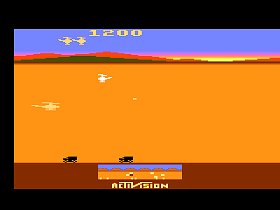
 The Game: You’re a lone attack helicopter jockey in unfriendly desert territory, trying to stop a seemingly endless attacking fleet of enemy jets from bombing a convoy on the ground. (Activision, 1982)
The Game: You’re a lone attack helicopter jockey in unfriendly desert territory, trying to stop a seemingly endless attacking fleet of enemy jets from bombing a convoy on the ground. (Activision, 1982)
Memories: Maybe the best example ever of Activision stealing Atari’s thunder right out from under it, Chopper Command is essentially the same game as Defender, with the singular exception that the enemy is bombing the ground-dwellers instead of trying to abduct them.
Centipede
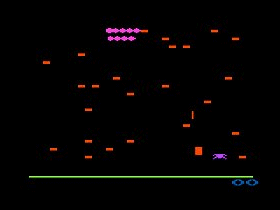 The Game: Centipedes, spiders and fleas invade your garden of ‘shrooms. Spiders follow an evasive course and can collide with you at any moment. Fleas poison the mushrooms, making them impervious to your fire (and thus giving the
The Game: Centipedes, spiders and fleas invade your garden of ‘shrooms. Spiders follow an evasive course and can collide with you at any moment. Fleas poison the mushrooms, making them impervious to your fire (and thus giving the  centipede impenetrable cover). And the centipede itself can split into many segments, and if it reaches the bottom of the screen, will turn around and start to move upward again, possibly catching you from behind. Every time you manage to completely “debug” the screen, you move up to a harder level. (Atari, 1982)
centipede impenetrable cover). And the centipede itself can split into many segments, and if it reaches the bottom of the screen, will turn around and start to move upward again, possibly catching you from behind. Every time you manage to completely “debug” the screen, you move up to a harder level. (Atari, 1982)
Memories: Centipede was a huge arcade hit, so it’s no wonder Atari wasted no time in creating the home translation. Though the Atari 2600 version of the game couldn’t compete with its arcade ancestor’s colorful graphics, the home version did get the point across.